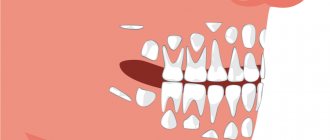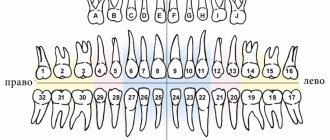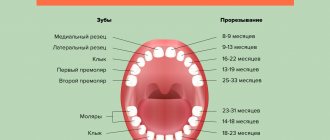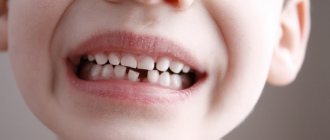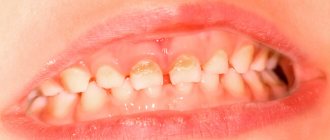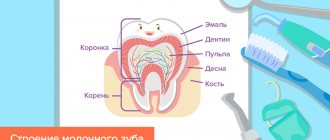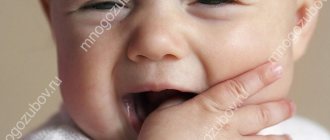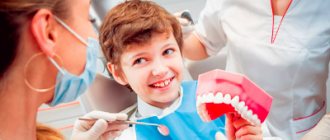When does a child's molars come out?
The eruption of a child’s molars is one of the most important periods in the development of a child’s body. It is quite painful, so parents need to be prepared for it and know when their baby’s molars begin to cut.
The first milky shoots are usually formed within 2 years, there are 20 of them in total. As already mentioned, among them there are two pairs of molars. The exact time when the first molar teeth begin to erupt has not been established. This depends on many factors: diet, heredity, climatic conditions of the region of residence, and the quality of drinking water.
If we talk about the first molars, they appear in the baby at the age of 12-17 months. Even if this process is delayed in your case, there is no need to worry. By the 32nd month they will definitely thin out. Second molars begin to erupt at 24-33 months, and the process is completed by 38-48 months. It must be taken into account that the growth and development of each child is individual. This also applies to teething. Even if the timing of the eruption of your child’s first molars is delayed or, conversely, they appear earlier in him than in his peers.
The growth of baby teeth usually stops by the age of three. By the age of five or six, the first signs of their change to radical ones begin to appear (in some children later). The entire process of formation of permanent teeth ends by the age of 12-14 years.
When and how do baby teeth change to permanent ones?
Starting from the age of six, the milk line is replaced by a permanent one. Replacement occurs in the same sequence in which baby teeth erupted. This process stretches from 6-8 to 13 years, but the formation of the jaws does not end there. Following the loss of milk, the following are cut:
- No later than 14 years - second large molars (“sevens”) (we recommend reading: differences between baby teeth in children and molars).
- From 15 years and older - third molars, “eights” or “wisdom teeth” (in some people they appear before the age of 30 or do not erupt at all). The table shows the replacement periods for baby teeth.
| Which jaw? | Which permanent ones erupt? | Age, years (boys) | Age, years (girls) |
| Lower | Central incisors | 6-7 | 6-7 |
| Upper | Central incisors | 7-8 | 7-8 |
| Upper | Lateral incisors | 8-9 | 8-9 |
| Lower | Lateral incisors | 7-8 | 7-8 |
| Upper | First premolars | 8.5-11 years | 8-10 years |
| Lower | First premolars | 9-12 years | 8.5-12 years |
| Upper | Fangs | Up to 12 years | Up to 12 years |
| Lower | Fangs | 9-11 | 9-10 |
| Lower | Second premolars | 10.5-13.0 years | 10-12,5 |
| Upper | Second premolars | 10.5-13.0 years | 10,5-12,5 |
Molars are being cut: symptoms
The first characteristic symptom of the beginning of the eruption of molars in a baby is that his jaw begins to increase in size. If the gaps between the baby teeth are quite small, then the body prepares to replace them with permanent ones - it creates all the necessary conditions for the growth of “adult” teeth.
The first molars announce their appearance quite seriously. This period brings the most pain to children and troubles to parents. The child sleeps poorly, becomes capricious, irritable, and may lose his appetite. Symptoms of molar teething may include a runny nose or cough, or an increase in the baby’s body temperature. According to doctors, these are not obligatory signs of eruption of molars; to a greater extent, they appear against the background of a general decrease in immunity and an increase in the vulnerability of the child’s body.
But, in any case, once the child reaches one year of age, parents should carefully monitor the child’s condition, the appearance of the symptoms described above, and act competently to relieve the baby’s unpleasant pain.
An almost obligatory sign of eruption of molars is increased salivation. At the second stage of tooth formation, this symptom is not as pronounced as the first time, but it can also cause inconvenience. By the age of 6-7 years, a child can already be taught to wipe his mouth and cheeks on his own, with a handkerchief or sterile napkins. If this is not taken care of, irritation will appear on his lips, cheeks and chin due to the increased sensitivity of the delicate baby skin (there are many different bacteria in saliva).
The eruption of molars in a child may be accompanied by symptoms such as diarrhea for several days. In this case, loose stools are a consequence of an infection entering the child’s body. The reason for this is that the baby often puts dirty hands or other objects into his mouth; copious salivation contributes to this, regularly washing the intestines. Short-term diarrhea (no more than three times a day) without the admixture of blood bodies is not dangerous for the child. But a doctor’s supervision will not be superfluous, since during this period, with a weakened child’s immune system, a new infection may be added and all symptoms may worsen.
At what age does the eruption of baby teeth end?
Young children teethe individually. There are situations when the front incisors emerge as early as 4 months. In general, long-term observations show a pattern of filling the dentition in children.
To find out the normal number of teeth a baby has, you need to use the formula. We subtract the number 4 from the age in months and find out how many units a child can erupt. For example, he is 10 months old. We calculate according to the formula. 10 – 4 = 6. Thus, at 10 months the baby is supposed to have 6 teeth. The table below shows the average time during which children erupt their first teeth.
| Pair number | Which jaw? | Name | How many months |
| 1 | Lower | Central incisors | 6 — 7 |
| 2 | Upper | Central incisors | 8 — 9 |
| 3 | Upper | Lateral incisors | 9 — 11 |
| 4 | Lower | Lateral incisors | 11 — 13 |
| 5 | Upper | Primary small molars | 12 — 15 |
| 6 | Lower | Primary small molars | 13 — 15 |
| 7 | Upper | Fangs | 16 — 18 |
| 8 | Lower | Fangs | 18 — 20 |
| 9 | Lower | Large molars | 24 — 30 |
| 10 | Upper | Large molars | 24 — 30 |
The table shows that the formation of the dentition is completed at 30 months. Thus, at the age of two and a half years, a healthy child has 20 teeth. A delay of up to six months is considered normal. Moms don't need to worry just yet. If the schedule violation exceeds 6 months, then you should visit a pediatric dentist.
Parents helping their child when his molars are being cut
The process of erupting molars is long and painful. During these periods, parents should try to be very attentive and tolerant towards their baby. To reduce pain and anxiety, pediatric dentists recommend using special gels that are cooled in teethers.
If your temperature rises or alarming symptoms such as runny nose or cough appear, you should definitely consult a pediatrician. The doctor will determine the exact cause and may prescribe anti-inflammatory drugs.
Teething is a period when increased attention to oral hygiene is required. For this age, you need to choose the right toothpaste for your child. For example, children's toothpaste from the ASEPTA baby series for children aged 0 to 3 years significantly reduces the number of harmful microbes in the child's mouth, so that the difficult period of teething passes without unnecessary hassle.
When permanent teeth do not appear for a long time
The absence of permanent teeth for too long can be due to several reasons: these are the genetic characteristics of the body, their immaturity, and the destruction of tooth germs by some kind of infection.
Only a dentist can determine the true cause. At the A-Medic Network of Medical Clinics clinic, they will take a picture of the jaw, which will show how the child’s permanent teeth are formed. Sometimes they can grow inside the gums. If nothing is visible on the image, the doctor may suggest solving the problem by installing dentures.
You may also be interested in
CHILDHOOD
Finger wipes from 0 to 3 years ASEPTA BABY
For gentle oral hygiene of babies and massage of gums during the eruption of the first teeth
More about the product
CHILDHOOD
Children's gel toothpaste from 0 to 3 years ASEPTA BABY
Designed for gentle care of baby's gums and baby teeth
More about the product
Differences between baby teeth and permanent teeth
The structure of primary and permanent teeth is generally the same, but there are several noticeable differences. Which are better not to neglect:
Baby teeth have whiter enamel, while permanent teeth have a slight yellowish tint. Milk teeth are not as strong as permanent teeth due to the lower percentage of mineral substances. The pulp of baby teeth is wider and thicker, while dentin and enamel are, on the contrary, thinner. This explains the facilitated, spontaneous removal of a shelf tooth - there are often situations when schoolchildren in class independently loosen and remove milk teeth that have served their purpose. In permanent teeth, the length is significantly greater, dominating over their width and cross-sectional area. The root of a baby tooth is thinner and shorter - a person is able to pull out a baby tooth without the help of specialists. Meanwhile, the permanent “embryo” of a real tooth under the shelf one is already ready to grow quickly and be born. The latter is achieved due to the dental gap, which has expanded by the time the non-permanent tooth falls out.
Experts' opinion
The pleasant-tasting ASEPTA baby gel does not damage the milk enamel of teeth, has a beneficial effect on the gums, and plant extracts prevent the development of inflammation in the oral cavity. Thanks to the pleasant taste of “tutti-frutti”, toothpaste helps to develop the child’s daily oral hygiene skills. The paste does not contain fluoride or abrasives and is suitable for daily oral hygiene of a child.
An analysis of the clinical effectiveness of the use of various therapeutic and prophylactic agents of the Asepta series, carried out in Novosibirsk, at the State Budgetary Educational Institution of Higher Professional Education "Novosibirsk State University", confirmed that the line is different:
- Pronounced hygienic;
- Anti-inflammatory;
- Hemostatic property.
Sources:
- Study of the clinical effectiveness of the use of therapeutic and prophylactic agents of the ASEPTA series in the treatment of inflammatory periodontal diseases in children and adolescents (I.V. Klimova) Irina Vladimirovna Klimova, Candidate of Medical Sciences, Associate Professor of the Department of Pediatric Dentistry, Novosibirsk State Medical University. Department of Pediatric Dentistry, Novosibirsk State Medical University.
- Prevention of recurrence of localized periodontitis in young A.K. YORDANISHVILI, Doctor of Medical Sciences, Professor, North-Western State Medical University named after. I.I. Mechnikov, Military Medical Academy named after. CM. Kirov, International Academy of Sciences of Ecology, Human Safety and Nature.
- Article “Treatment and hygiene features for mild and moderate periodontitis” by S.B. Ulitovsky head Department of PFS, Professor, Doctor of Medical Sciences, A.A. Leontyev Associate Professor of the Department of PFS, Ph.D. PSPbSMU named after. I.P. Pavlova
Features of molars
Large molars differ from other groups not only in external characteristics, but also have other features :
- these are the largest units in each dental arch;
- have the largest chewing surface;
- have a powerful root system;
- the upper molars are slightly larger than those on the lower jaw;
- have a stronger surface coating;
- able to withstand weight up to 75 kg;
- upper molars have 4-6 canals, while lower units generally have only 3 canals;
- maxillary molars have 3 roots (palatal, buccal-medial, buccal-distal), less often 4;
- the chewing teeth of the lower jaw have only 2 roots;
- wisdom teeth are the very last molars, which may appear by the age of 50 or not appear at all;
- the last molars are very often located not in the chewing arch, that is, they can grow horizontally or with a slight slope, located buccally or towards the tongue or palate;
- wisdom teeth have from 1 to 5 chewing cusps;
- the last molars often have a complex root configuration (curvature, fusion).
All this entails the peculiarities of treatment of such teeth. The presence of a large number of complex root canals, as well as difficult access compared to other groups of teeth, requires highly qualified doctors and modern equipment for high-quality therapy.
In dental practice, molars are considered the heaviest units, especially wisdom teeth. Proper care and regular preventive examinations will help keep them healthy. When the first signs of damage to the molars appear, we recommend that you immediately sign up for a consultation at our KAS+ dentistry. Timely detection of dental problems guarantees their high-quality treatment with minimal risk and long service life.
